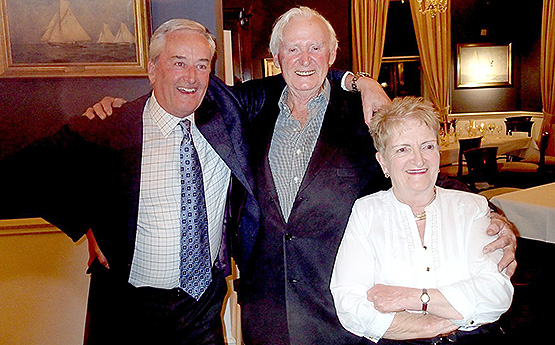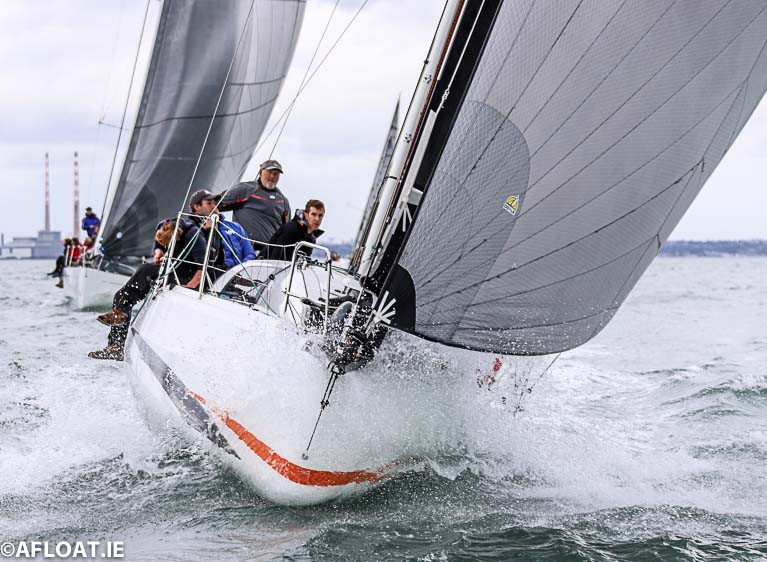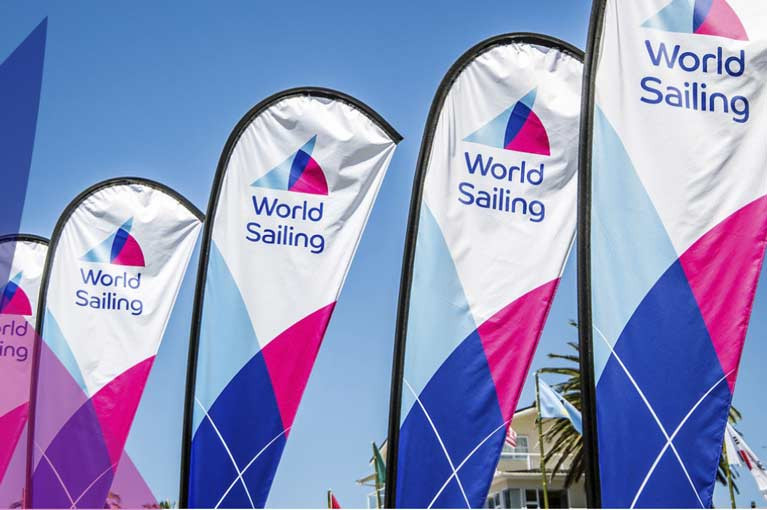Displaying items by tag: Offshore Sailing
Irish Sailor Kenny Rumball to Break Down Barriers With New Offshore Racing Academy
After two seasons in France campaigning a Figaro 3 in both double-handed and solo sailing disciplines, it has become apparent to Irish offshore sailor Kenny Rumball that there are no grassroots feeds to the professional offshore racing scene in Ireland. The Dun Laoghaire Harbour dinghy and keelboat champion says this eliminates the progression of Irish sailors representing their country abroad in anything but the usual pathway of youth and Olympic high-performance sailing.
The prospect of a double-handed offshore mixed class for Paris 2024 sparked the imagination of many a sailor, sponsor and spectator, but unfortunately, this discipline will not be happening.
France is the hub of the offshore sailing scene and has quietly been so for many years. France plays host to the most significant offshore races, including the Vendee Globe, the Transat Jacques Varbe, Route Du Rhum, La Solitaire du Figaro, the list goes on…
 Irish offshore sailor Kenny Rumball
Irish offshore sailor Kenny Rumball
However, there are comparatively few Irish sailors that have ventured into the scene.
In the past, we have had competitors in La Solitaire du Figaro, including Marcus Hutchinson, Damian Foxall, Dave Kenefick, Mick Liddy, Joan Mulloy and our most successful solitaire sailor so far, Tom Dolan.
 Ireland's most successful La Solitaire du Figaro sailor, Tom Dolan
Ireland's most successful La Solitaire du Figaro sailor, Tom Dolan
Fewer still have gone on to pursue the ultimate offshore challenge in France, the Vendee Globe. Enda O'Coineen has been our most successful so far, but no Irish sailor has completed the Vendee Globe.
Why is this? Why do so few Irish sailors not take the relatively short ferry trip to France?
 Enda O'Coineen - Ireland's only ever entry in the Vendee Globe Race
Enda O'Coineen - Ireland's only ever entry in the Vendee Globe Race
It became increasingly apparent that most young Irish sailors know very little about the offshore scene in France and the progression it takes to achieve results in races like La Solitaire du Figaro, the Mini Transat or the Transat Jacques Varbe.
I want to break down these barriers by getting young Irish sailors, both male and female, to France and exposing them to the different classes in the French offshore sailing community, including the Mini 6.50 fleet, the Beneteau Figaro 3 Fleet, the Class 40 fleet and even the ultimate IMOCA fleet.
Unfortunately for many of these classes, the races are solo or double-handed, except the Class 40 fleet, where there are unlimited crew in some races. The Class 40 is not a one-design fleet but is a 40-foot' box rule' class that aims to be cost-effective through the limitations of exotic build materials. The fleet was devised initially to bridge the gap between smaller 30-foot ocean racing boats and the Imoca 60 class of 60-foot offshore racing boats.
Through this boat class, I aim to give young Irish Sailors exposure to the elite offshore racing world that exists in France.
Some of the events available for Class 40 next year include;
- Les 1000 milles des Sables
- Grand Prix Guyader
- Normandy Channel race
- Armen Race or Myth of Malham
- Au Large de St Tropez
- SSE Renewables Round Ireland Yacht Race
- Drheam Cup (Course qualifier RDR)
- Sevenstar Round Britain and Ireland race
However, to help Irish offshore sailors progress, I'm looking for partners to help provide these offshore sailing experiences and grow the presence of Irish sailors in these demanding leagues.
There are costs to sailing, and France has shown the value of sponsorship to companies both large and small. Companies are fighting to become the title sponsor of the next Figaro, Class 40 and Vendee Globe campaigns.
 Sponsor Medallia has purchased GB sailor Pip Hare a better boat for the 2024 Vendee Globe Round the World Race
Sponsor Medallia has purchased GB sailor Pip Hare a better boat for the 2024 Vendee Globe Round the World Race
There is a massive return on investment for companies within and outside France evident by a company such as Medallia who came on as a late sponsor for Pip Hare in the last Vendee Globe but got such a return on their spending, Medallia has already purchased Pip a better boat in anticipation of the next Vendee Globe in 2024!
The statistics speak for themselves; in the last Vendee Globe, there were 350,000 followers on Facebook alone, more than the number of followers on the World Sailing website, for example.
Ed's note: In an exciting few weeks for Irish offshore sailing, Cork pro Justin Slattery added a Middle Sea Race record to his CV as two Irish offshore solo racers compete in Transatlantic races. Galway's Yannick Lemonnier is racing in the MiniTransat as Afloat reports here and Wicklow's Jim Schofield in the new Adventure Globe 5.80 Transat Race here.
Mixed Offshore European & World Championships Set for 2021 Marina Militare Nastro Rosa
World Sailing and the European Sailing Federation (EUROSAF) have confirmed that the 2021 Hempel Offshore World Championship and the EUROSAF Mixed Offshore European Championship will be held alongside the 2021 Marina Militare Nastro Rosa regatta in Italy.
In addition to today’s announcement, World Sailing is delighted to announce that Hempel, Official Coatings Partner, have extended their support of the sport by moving into offshore sailing.
They will become title partners of the Offshore World Championship in 2021.
The Marina Militare Nastro Rosa is a month-long celebration of the sport held in eight stages at eight of the most stunning Italian locations with famed sailing histories. In 2021, the Nastro Rosa will be held from 27 August to 26 September.
The first half of the Nastro Rosa, held late August / early September, will be hosted on the Tyrrhenian Sea and will encompass the EUROSAF Mixed Offshore European Championship and qualification events. The second half will be held on the Adriatic Sea with the Hempel Offshore World Championship and qualification events scheduled to take place in the second half of September and finishing in Venice.
Both Championships will be two-person mixed competitions (one man, one woman). The EUROSAF Mixed Offshore European Championship and the World Championship are both open to nations from every continent.
The Notice of Race for the 2021 Hempel Offshore World Championship and the EUROSAF Mixed Offshore European Championship can be downloaded below.
World Sailing Chief Executive Officer, David Graham, commented, “The Hempel Offshore World Championship will enable the world’s leading mixed crews to face off against each other for the first time along the Adriatic Coast.
“The 2021 EUROSAF Mixed Offshore European Championship and Hempel Offshore World Championship will showcase the best of mixed offshore double-handed sailing and I am looking forward to seeing the athletes on the water competing.”
Riccardo Simoneschi, Head of the Nastro Rosa Organising Authority concluded, “The Marina Militare Nastro Rosa Tour is a medium to long term project aiming to offer a simplified version of the whole sport of sailing with its three disciplines - Offshore, Inshore and boards in a very understandable format for the audience.
“We are delighted and honoured to cooperate again with World Sailing, EUROSAF and FIV and hosting these two important championships in the offshore program of the Marina Militare Nastro Rosa. Offshore racing is, by far, the closest performance discipline to the largest audience and sailing community around the world.”
Offshore Sailing—Is this the New "Go To" for 2021?
Mark Mansfield, Olympian and Professional sailor and a member of this year's Fastnet 450 Race organising committee reckons lessons learned in this COVID-hit 2020 sailing season means there can still be good compliant big boat racing even in these strange times.
The success of the 'Pop up' Fastnet 450 race and the ongoing success of the ISORA series this year is showing the way forward for what can be done in the future—if COVID 19 continues to be an issue next season and even beyond that. We only have to look at the season gone by to see the litany of cancelled events due to the pandemic and changing Government regulations.
First, there was the early and correct postponement (until July 2022) of the huge 300-year celebrations of the Royal Cork at Cork week 2020. Then Wave Regatta at Howth and the Round Ireland at Wicklow moved their dates to September, where eventually both had to cancel. The Scottish Series, an event always well represented by Irish Boats was next to go, then Bangor Town Regatta on Belfast Lough, then Calves Week in Schull and WIORA in Tralee followed. Most of these had issues with too many numbers gathering after racing, as Government COVID regulations were eased, then tightened again.
Clearly, with social distancing and maximum numbers allowed to gather at events, the social type big 3/4/5/ day regattas are going to be in doubt, perhaps even into next year, until this pandemic can be arrested.
Club racing and, in particular, Dublin Bay Sailing Club racing at Dun Laoghaire was able to go ahead, with the emphasis on the sailing and not gathering afterwards and keeping within Pods and maintaining Government Guidelines. On this point, Dun Laoghaire benefits over other venues in dealing with COVID ashore because of the enormous footprint that contains four separate clubhouses all neatly in a row in order to disperse sailors,
 George Sisk's WOW, an XP44, was an early leader in this year's ISORA Series from Dublin Bay Photo: Afloat
George Sisk's WOW, an XP44, was an early leader in this year's ISORA Series from Dublin Bay Photo: Afloat
The clear winners, however, have been the success of coastal and offshore racing this year. ISORA has always been the driving force for offshore racing in Ireland, pushed on hard by Peter Ryan in Ireland and Stephen Tudor in Wales. The intermingling of the two fleets was not allowed to happen, but a fix was put in place and on this side of the Irish Sea, great racing has been had by Irish based boats, with the series winding up in a week or two.
 The Grand Soleil 40, Nieulargo of the Murphy Family from Cork
The Grand Soleil 40, Nieulargo of the Murphy Family from Cork
The Round Ireland race was to have been one of the year's highlights with over 50 entries received, 30 from Ireland, but for various reasons, this was not possible to proceed. With many crews locked and loaded for this race, it was easy to see how a new pop up race, the Fastnet 450 could get 20 entries in just at two-week time frame. This turned into a very competitive, though tough 270-mile race from Dun Laoghaire around the Fastnet and into Cork, with the eventual winner being the Grand Soleil 40, Nieulargo of the Murphy Family from Cork. About 12 of the fleet were ISORA regulars who had honed their skills during the season on the shorter Coastal and overnight races. This event ensured COVID compliance with the emphasis on the racing and no before and after gatherings. Crews stayed in Pods. Zoom briefings, Zoom prizegivings and no social occasions meant no large gatherings.
So what about Next Year? 2021 already has some big events planned.
- Scottish Series –Tarbert May – 2021
- ICRA Nationals, NYC, Dun Laoghaire – May 2021
- Dun Laoghaire to Dingle Race – 9th June
- 2021 Dun Laoghaire Regatta – July 2021
- Bangor Town Regatta – July 2021
- Sovereign's Cup, Kinsale – July 2021
- Calves Week, Schull – Aug 2021
- Perhaps another Fastnet 450 Race – to link in with D to D, ISORA and other big events?
 The all-conquering JPK 10.80 Rockabill VI was the ISORA champion for 2019 and leads again in 2020
The all-conquering JPK 10.80 Rockabill VI was the ISORA champion for 2019 and leads again in 2020
Clearly a lot happening in Ireland, with some events even overlapping presently with each other, which I am sure will get resolved. Add to this, 2021 is a Fastnet Race year with a new finishing venue in Cherbourg, France.
Will it all happen? This is the Question. Will COVID 19 be suppressed to such an extent that large gatherings will again be able to happen? Only time will tell.
What is clear however is that Coastal and Offshore racing require fewer gatherings of people allowing social distancing to be maintained. These races are more about the sailing and not the socialising as often boats arrive at the finish well apart, and crews tired but satisfied, head home. So if an owner was going to pick and choose events to concentrate on, offshore and coastal races are more likely to happen than the inshore series. That has been made clear this year.
So what Offshore and Coastal racing is there next year?
South Coast
Kinsale had a very successful Kinsale-Fastnet-Kinsale race this year and that will happen again in 2021. The very successful Fastnet 450 is being debriefed as we speak and an annual event likely to link in with other events. Who knows, it could be a Cork-Fastnet-Dun Laoghaire race next year (maybe less beating) to link in with Volvo DL week. Or maybe even the same course as this year to get boats down for the Sovereigns Cup?
 SCORA’s Fastnet 450 team for the inaugural race were Johanna Murphy (Commodore), article author Mark Mansfield, and Annamarie Murphy (Rear Admiral, Royal Cork YC)
SCORA’s Fastnet 450 team for the inaugural race were Johanna Murphy (Commodore), article author Mark Mansfield, and Annamarie Murphy (Rear Admiral, Royal Cork YC)
There is also some talk of a Coastal/Offshore series down south, similar but smaller than ISORA, where a number of Day Coastal races would be run, along with the two larger offshore races between Cork and Kinsale clubs with an overall series winner. This might encourage boats from as far away as Kilmore Quay to the East to be involved, and Foynes to the West.
East Coast
Clearly ISORA does a great job of arranging good coastal and offshore night races from Dun Laoghaire. Cross-Channel Irish Sea racing may still prove a problem in 2021 (we hope not) but if numbers are anything to go by, even an Irish based series in 2021 is likely to attract larger entry numbers.
Dun Laoghaire to Dingle race - The flagship event run by the National Yacht club can, with the benefit of hindsight from what happened in 2020, run a successful and compliant race in June, with the sailing being the important area and not the socialising. Hopefully, the COVID 19 situation will have improved to allow some socialising, but the important thing is to be able to pull back to a compliant race.
Northern Ireland
Why not arrange some Coastal and Offshore races between Dublin and Northern Ireland ports in 2021, maybe to link in with their big events? A race to get boats from Northern Ireland down to Dublin for Volvo Dun Laoghaire regatta in Early July, followed by a race to get boats up to Bangor week a week or so later.
 When John Harrington's IMX 38 Excession from Royal Ulster Yacht Club made the Dun Laoghaire Harbour start line in August, he became the first Northern Ireland yacht to compete in ISORA racing in many years
When John Harrington's IMX 38 Excession from Royal Ulster Yacht Club made the Dun Laoghaire Harbour start line in August, he became the first Northern Ireland yacht to compete in ISORA racing in many years
The bottom line—there is more likelihood that offshore and coastal events will happen in 2021 than the large inshore events that are centred around Yacht clubs. Let's plan for the Coastal and offshore events in 2021 and hope the big inshore events can still happen.
Great sailing to everyone for the rest of the year—there is still plenty of time to get some good racing in with clubs planning on extending the 2021 season later than normal.
2021 can be great, maybe a bit different, but great all the same.
World Sailing has cancelled the 2020 Offshore World Championship, due to be held alongside October’s Rolex Middle Sea Race in Valletta, Malta, as a result of the COVID-19 pandemic.
The many uncertainties created by the COVID-19 pandemic have forced the postponement of the one-design L30 charter boat production and distribution across Europe, and have disrupted the ability of Member National Authorities (MNAs) to run qualification events to decide who may enter the event. In light of these difficult circumstances, World Sailing’s Board of Directors decided it is prudent and fairer to cancel the 2020 edition of the Offshore Worlds. The event was expected to feature teams of mixed sailors from 20 nations, including Ireland, from each continent. The inaugural edition of the Offshore World Championship will now take place in 2021.
In the meantime, the Royal Malta Yacht Club is continuing its preparations for the 2020 Rolex Middle Sea Race, while closely monitoring developments with COVID-19 and following the advice and guidance from the World Health Organisation and the Maltese government. At this point, the club has every intention to run the 606nm offshore race should circumstances permit.
World Sailing and the Royal Malta Yacht Club are also in discussion about holding the 2021 Championship alongside the 2021 Rolex Middle Sea Race.
National Yacht Club Dinner Salutes Former Offshore Skippers & Crew: 'Order of the Ancient ISORA'
Last Friday, the National Yacht Club in Dun Laoghaire saw a gathering of NYC members who raced in ISORA in the 1980’s. The dinner was attended by over 40 members and guests, representing the skippers and crew of six boats.
Represented there were:
• “Lightening” – Liam Shanahan Snr
• “Emircedes” – Michael Horgan Snr & Peter Ryan
• “Humphrey Go Kart “- Vincent Farrell
• “Eliminator” - Peter Cullen.
• “Boomerang” – Paul Kirwan
• “Avanti “ - (Brendan Briscoe)

Peter Cullen, Liam Shanahan Snr and Anita Begley
The night was organised by Anita Begley who raced on “Avanti”, owned by the late Brendan Briscoe. Anita also raced on “Emircedes” and “Eliminator”. The dinner was a great social event with amusing anecdotes of taking part in ISORA races being recounted in the many casual after dinner speeches.
Liam Shanahan recounted the fierce competitiveness between “Lightening” and Peter Cullen’s “Eliminator” during races when boats crossed the Irish Sea three times in the race!! Despite the competitiveness during the race, the famous “Spirit of ISORA” was always present when the boats finished.
Present Chairman of ISORA, Peter Ryan, reiterated that is was great to see the keen and constant interest in ISORA by those members who sailed in races over 30 years ago. The memories of those incidents that occurred during and after the races years ago, as recounted by those after dinner speeches, was a testament to the future longevity and success of ISORA.
The evening was such a success that there were suggestions that the dinner could become an annual event and involve all previous skippers and crew who sailed in ISORA in the past.
Boats Head for 'Foyle Days' 2011
Over the years she has changed hands between Dutch and UK interests for recreational use. Several years ago she starred in the RTE TV reality show 'Cabin Fever' where she replaced the show's first ship Camaret of Cornwall (branded as 'Cabin Fever') after it ran aground off Tory Island.
During the two-day festival (11am-5pm) the boating community at the event will include the Coleraine Yacht Club, Foyle Paddlers, Foyle Punts, Lough Foyle Yacht Club, Lough Swilly Yacht Club, Moville Boat Club, RNLI and the Foyle (SAR) Search and Rescue.
Visitors to Foyle Days can call to the Clipper stand and learn more about the city's entry of the Derry~Londonderry boat in the 2011-2012 Clipper Round the World Race. Learn more about the countries the crew will visit and also how to get involved in the event. For more information about the race, at 40,000 miles is the world's longest race go to www.clipperroundtheworld.com/
Running alongside the festival a continental market with 40 stalls will be open to all at the recently revamped Guildhall Square. For further details about Foyle Days click here.
- Clipper Race
- Maritime Festival
- RNLI
- Lough Foyle Yacht Club
- Lough Swilly Yacht Club
- Moville Boat Club
- Derry
- Londonderry
- Tory Island
- JOHANNA LUCRETIA
- Foyle Days
- RTE TV
- Cabin Fever
- Camaret of Cornwall
- Grounding
- Reality TV show
- Clipper Around the World Race
- Guildhall Square
- Continental Market
- Coleraine Yacht Club
- Foyle Search and Rescue
- Foyle Paddlers
- Foyle Punts
- Offshore Sailing
- Clipper Round The World Race
- JOHANNA LUCRETIA

































































